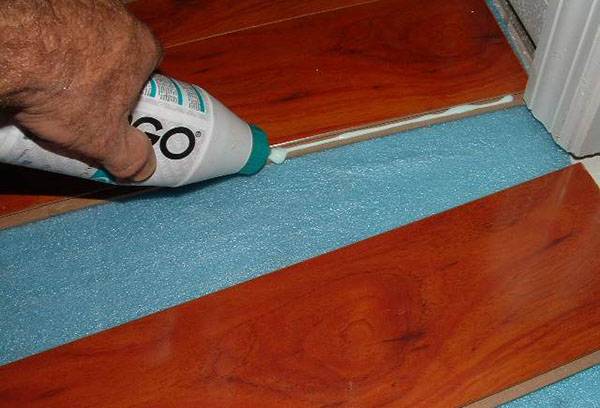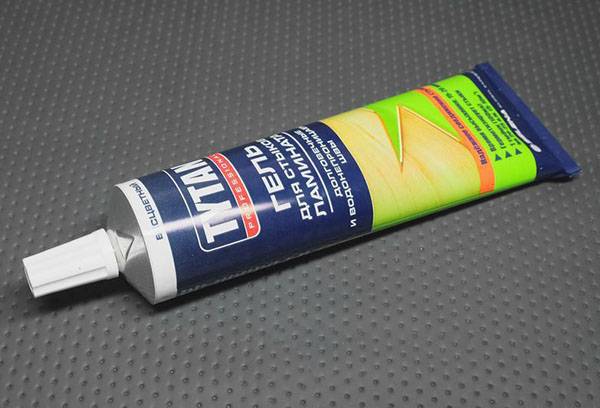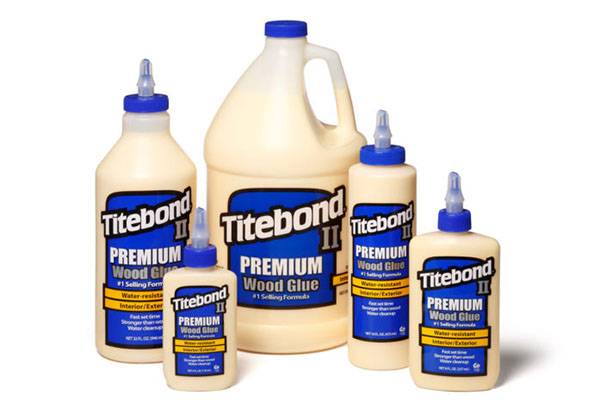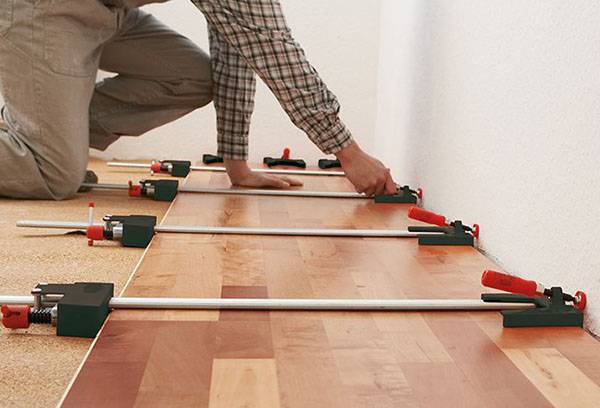What adhesive is suitable for laying laminate flooring?
Laminate is one of the most popular building materials. If previously it was used exclusively as a floor covering, now walls and ceilings are also finished with fiberboard modules. Laminate manufacturers have developed a locking system for fastening panels, which does not provide for rigid gluing to the surface being treated. Laminate glue is needed only to make the connection more durable and protect the ends of the planks from moisture and other damage.

Functions of glue when laying laminate
The laminate is based on high-density fibreboard. This finishing material has many advantages, such as resistance to abrasion and exposure to sunlight, moisture resistance and durability. However, due to the fibrous structure of fiberboard, plates with untreated ends can delaminate at the joints, form gaps, and swell when water gets into the cracks.
To avoid such troubles and provide the coating with additional protection and an attractive appearance, you should use a special adhesive composition, the choice of which must be approached with all responsibility. The adhesive must be fully compatible with the laminate, ensure strong adhesion of the panels to each other and excellent sealing of the seams, and retain its properties for many years.
Features and types of adhesive compositions
Laminate adhesive can be purchased at any hardware store or ordered online.The main thing is to choose a high-quality composition from a time-tested manufacturer. Otherwise, the appearance of the new coating will be spoiled by dirt accumulated in the cracks between the panels and protruding edges.
There are several types of glue that are suitable for fiberboard products.
- An adhesive based on synthetic or epoxy resin. This adhesive composition does not allow moisture to pass through, forms a strong and durable connection, and resists chemical and mechanical influences.
- Two-component adhesive based on phenol-formaldehyde resin. It is used for gluing wood and is characterized by special joint strength and resistance to temperature changes.
- The one-component adhesive is durable and flexible. Does not emit an unpleasant odor and does not pollute the environment with harmful substances. The most suitable composition for multi-storey residential buildings.
Important!
When laying laminate flooring, do not use water- or oil-based adhesives.
An alternative to glue for treating joints is a sealant. The main thing is to choose a color that matches the color of the panels. The best representatives of these adhesives are ClickGuard and Masterfix.
Each master decides for himself whether it is advisable to additionally fasten the panels with glue when laying laminate on a wall, floor or ceiling. By working with glue, you can guarantee:
- strength and durability of laminate fastening;
- protection from moisture and the inability to form gaps between panels;
- long service life of the treated surface.
However, gluing laminates also has negative consequences:
- You cannot start using the floor immediately after finishing work is completed; you must wait at least 12 hours;
- It is not recommended to make a heated floor, since when heated, the glue can melt and the panels can become deformed;
- glued lamellas cannot be unstuck, so dismantling the floor is impossible.
Before using laminate adhesive, think carefully about whether it is worth it. If it may be necessary to dismantle the laminate, it is better to use only a locking connection, without gluing.
Which glue is better - a review of products from well-known manufacturers
Among the many well-known manufacturers producing adhesive compositions, the most popular are the German companies Henkel and Kiesel, the French company Kleo, and the American Titebond. Here is a brief overview of the products produced by these manufacturers.
- Thomsit P 640
Water-dispersed adhesive from Henkel has good adhesion and is capable of providing high strength when gluing laminate flooring. The product is water resistant, solvent free and environmentally friendly. It is sold in 0.5 liter plastic bottles equipped with a special nozzle for uniform application of glue. Thomsit is a universal adhesive suitable for working with any wood surface.
- Laminate Kleo
The French company Kleo specializes in the production of adhesives for laminate flooring. Thanks to the latest technologies, the specialists of this company have developed a highly effective adhesive for laying laminate flooring, durable and elastic, without additives in the form of organic solvents. Laminat Kleo adhesive is easy to work with as it can be easily removed from the laminated surface. If excess glue gets on the front side of the panel, it can be removed with a soap solution.
- Titebond II Laminate
One-component Titebond II Laminate adhesive, produced by American specialists, contains a polyaliphatic emulsion and is an improved professional adhesive composition for Premium II wood. Recommended for laying laminate flooring when installing heated floors. After the glue dries, a durable transparent layer is formed.
- Kiesel
The German product Kiesel is used to connect panels to each other when laying laminate. The highest point of adhesion is reached within seventy hours after completion of installation work. This means that the opportunity to start using the floor covering appears much earlier than when using adhesive mixtures from other manufacturers. Kiesel does not contain harmful or toxic substances, so the adhesive product from German manufacturers is considered safe and environmentally friendly.
Each of the listed brands meets all the requirements for adhesive compositions for laminate flooring, so you can safely buy any of these products.
Laying laminate flooring using glue
For an experienced craftsman, laying the laminate and fastening the panels with glue will not be difficult. However, if you are doing such work for the first time, questions may arise, and you cannot do without expert advice. Here are detailed instructions for finishing a laminate floor using glue.
Important!
You can start laying the laminate at an air temperature of +15°C and low humidity in the room.
- The first panel is laid with a groove against the wall. A technical gap of about 10 mm is left between the laminate and the wall. Installation must be carried out in the direction of incidence of light and with the panels shifted.
- The end of the next panel is greased with glue, evenly squeezing the composition out of the tube.When performing this work, you must try to coat all areas without exception and at the same time not overdo it with glue.
- The panel is inserted into the groove with a tongue and groove and its position is adjusted by tapping it with a wooden block or mallet. If excess glue appears, it must be removed immediately with a damp cloth. The procedure is repeated until the first strip is completely installed.
- Before installing the second strip, one of the panels is cut in the middle to ensure a staggered arrangement of the lamellas.
- The side part of the short panel is smeared with glue and attached to the lamellas of the first strip. Do the same with other flooring elements until the second row is installed.
- After installing the third row, you need to take a break for 2 hours and let the glue dry, after which you can continue working.
- Having installed the last row, they knock out the entire structure using a crowbar.
Having dealt with some of the subtleties that arise when laying laminate flooring using glue, you can install a new floor covering in your apartment without outside help and extra costs. The main thing is to choose a high-quality finishing material and an effective adhesive intended specifically for laminate flooring.


